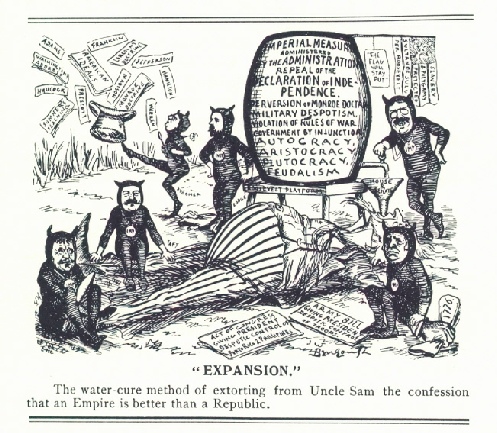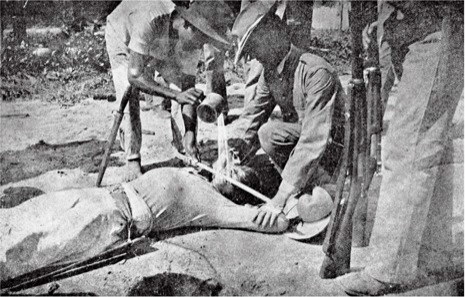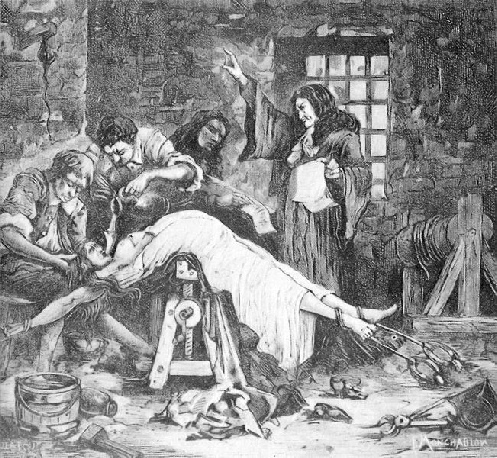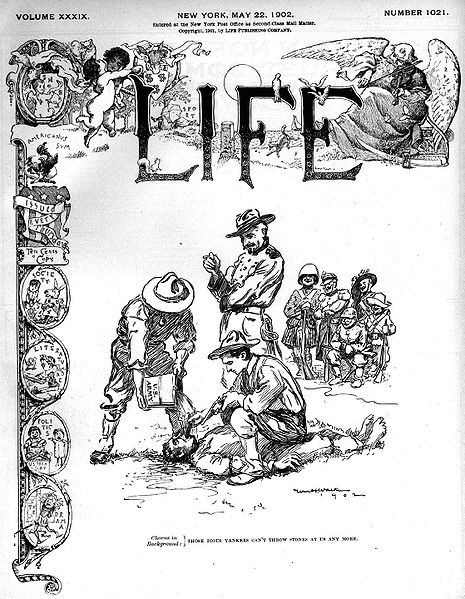

Exploring our past to sort out myth from reality
Share this Page on
Facebook or Twitter

These are the voyages of the TimeShip Anachron.
Our Mission: To boldly explore the past, dispelling
mythinformation and mythconceptions
of American History along the way.
 Visit us on Facebook
Visit us on Facebook
Meet MythAmerica SNAPSHOT
The “Water Cure”

I think many Americans, in the heat of their own political rants about current political leaders, tend to act as if whomever they are despising at the moment… say, President Obama…is the worst scoundrel in American history. Why, he’s trampling all over the Constitution, they may snarl. He is acting like a dictator! He’s making a mockery of the ideals of the Founding Fathers.
It would appear that many have historical blinders on that prevent them from realizing that Americans have had the same concerns regularly throughout the past 235+ years, no matter which party’s man is in the Whitehouse.
In 1902, it was Republican President Theodore Roosevelt who was the object of almost the same accusations, as you can see in the political cartoon above from that year. He was charged with casting out the ideals of the Founding Fathers, with trying to totally undermine the Constitution, with being a despot.
So what was the reference to “The Water Cure” in the cartoon? Although this term was in use in the mid-
After the US had played a part in “liberating” the Philippines from Spain in the 1898 Spanish-
During that war, the US public was surprised to hear rumors of mounting atrocities being committed by American troops. And “the water cure” was among these
A letter by A. F. Miller, of the 32nd Volunteer Infantry Regiment, published in the Omaha World-
No, surely Americans could not be using such diabolical methods, more suited to heathen peoples like the ancient Assyrians—or the European religious despots of the Inquisition. Folks back home in the States no doubt thought that this story was a mere “Urban Legend,” invented by the author of the letter.
Until they saw the photograph.

A picture of a “water detail,” reportedly taken in May, 1901, in Sual, the Philippines.
And more vivid descriptions by a number of eye witnesses of similar incidents followed. It soon became impossible to deny that this was going on.
Water cure was among the forms of torture used by American soldiers on Filipinos during the Philippine-
In spite of Roosevelt’s assurance that “we” couldn’t tolerate such a thing as any kind of torture, the leadership of the military in the Philippines evidently weren’t kept informed of this. The water cure was widespread.
Roosevelt’s claims that it was just some sort of “Filipino” method we "borrowed" was ludicrous. Perhaps he was just historically ignorant (although I seriously doubt that.) The method had been used by Europeans since at least the 1400s. In France it was even “legally” used by the government regularly from the Middle Ages to the 18th century.
It was known as being put to “the question”, with the ordinary question consisting of eight pints (3.6 litres) of water forced into the stomach, and the extraordinary question consisting of sixteen pints (7.3 litres).
The French poet and criminal François Villon was subjected to this torture in 1461. Jean Calas suffered this torture before being broken on the wheel in 1762. The true case of the Marquise of Brinvilliers [see photo below]was reported in fiction by Arthur Conan Doyle in “The Leather Funnel”, by Alexandre Dumas, père [author of The Three Musketeers and The Count of Monte Cristo] in The Marquise de Brinvilliers and by Émile Gaboriau in Intrigues of a Poisoner. More recently, water cure was used by the French military on Algerian prisoners during the Algerian war of independence. [Wiki]

Marquise of Brinvilliers being tortured.
A particularly gruesome description of just how the cure was administered, which I will not share here, is included in the article about the water cure on Wikipedia, provided by survivors of an incident of the use of the cure by the Dutch in the East Indies in 1622.
And, contrary to the implication of Roosevelt’s comments, “the cure” had been common among some police departments in the US for a long time.
The use of “third degree interrogation” techniques in order to compel confession, ranging from “psychological duress such as prolonged confinement to extreme violence and torture”, was widespread in early American policing as late as into the 1930s. Author Daniel G. Lassiter classified the water cure as “orchestrated physical abuse”, and described the police technique as a “modern day variation of the method of water torture that was popular during the Middle Ages.” The technique employed by the police involved either holding the head in water until almost drowning, or laying on the back and forcing water into the mouth or nostrils. Such techniques were classified as “‘covert’ third degree torture” since they left no signs of physical abuse, and became popular after 1910 when the direct application of physical violence in order to force a confession became a media issue and some courts began to deny obviously compelled confessions. The publication of this information in 1931 as part of the Wickersham Commission’s “Report on Lawlessness in Law Enforcement” led to a decline in the use of third degree police interrogation techniques in the 1930s and 1940s.
In 1983 San Jacinto County, Texas, sheriff James Parker and three of his deputies were convicted for conspiring to force confessions. The complaint said they “subject prisoners to a suffocating water torture ordeal in order to coerce confessions. This generally included the placement of a towel over the nose and mouth of the prisoner and the pouring of water in the towel until the prisoner began to move, jerk, or otherwise indicate that he was suffocating and/or drowning.” The sheriff was sentenced to ten years in prison, and the deputies to four years. [ibid]
In any event, Roosevelt’s claims notwithstanding, it is obvious that by the time of the 1902 political cartoon, illustrating a demonic President Roosevelt administering the water cure himself to Uncle Sam, the term and its implications were widely known by the American public. As you can see by this 1902 cartoon on the cover of Life magazine.

The caption notes that the Filipinos in the background are saying, “Those pious Yankees can’t throw stones at us any more.”